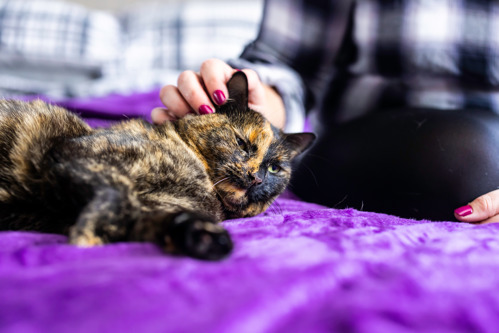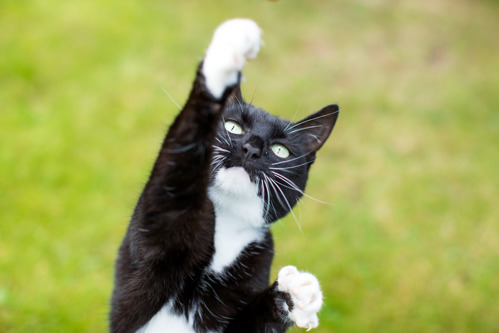Cat behaviour expert Nicky explains aggression from a cat's point of view
Many people experience their cat suddenly attacking them while they are giving them a fuss. It can be very confusing or upsetting. The cat appears to have asked for a fuss, only to then show ‘random’ aggressive behaviour.
“Cats don’t behave randomly or do things out of the blue, even if we can’t see a logical explanation,” says Nicky Trevorrow, a Clinical Animal Behaviourist. “We need to look at things from the cat’s perspective, which can be very different from our own.”
Why does my cat suddenly attack me when I fuss them?

“Being stroked by a human is not a natural behaviour for a cat to accept,” says Nicky. “They learn to be comfortable with interactions with people during their kitten socialisation period, when they are two to seven weeks old. Some cats are more naturally receptive to these interactions than others.”
“This can also be directly related to the amount of human interaction the cat has had during their socialisation period. The more positive interaction carried out during this time, the more likely the kitten will be well adjusted to everyday life and human interactions.” Find out more about kitten socialisation.
Follow these steps to help your cat feel more comfortable with physical interactions:
- Sit quietly with them when you won't be interrupted. Keep very calm.
- Keep interactions very short and stop before the cat reacts. Some cats don’t appreciate long cuddles and lots of stroking.
- Some cats may prefer to spend time playing and running around. Games and play are a better way of spending time with these cats than cuddles.
- Don’t try to provoke a reaction. Stop stroking when you notice twitching or backwards-facing ears, dilated pupils, tail swishing or sudden tensing.
- Reward the cat with a small treat. Praise them for behaving in a relaxed way and then leave them alone.
- Never punish the cat, including verbal and physical punishment. This will only encourage further aggressive behaviour. Especially if the cat has underlying anxiety.
Sensitive areas of a cat

“As with any behavioural change, it is crucial to rule out medical problems, especially pain, as that can cause a cat to attack,” says Nicky. “Remember that cats are the masters of disguise when they are in pain so it can be difficult to tell. If your vet says your cat doesn’t have any medical reasons that would cause them to be aggressive, here are a few tips for interacting with your cat.
“Cats can get quite stimulated or excited when they are playing or in ‘hunting mode’. It is generally not advisable to touch any cat in this state.”
“Even when touching a calm, relaxed cat, there are many places on the body that are quite vulnerable or sensitive. As a general rule, many cats don’t like to be touched in these places and might lash out.”
Places to avoid touching on a cat:
- belly (which for some cats can include their sides and chest too)
- paws
- under legs (for example, their armpits)
- legs (‘trousers’ or back legs)
- stroking the fur against the normal direction
- bottom half of back (particularly if stiff or painful)
- base of tail (cats are divided on this area though!)
- genital area
“All cats are individuals though. Some cats may seem to tolerate or, in some cases, even appear to like being touched in these areas. But most cats don’t like being touched in these areas.”
Does your cat really want to be stroked?
“It is a common misconception that cats who roll onto their backs and show their belly want it to be touched,” says Nicky. “This behaviour is often seen after you’ve returned home and is used as a greeting. When cats do this they are communicating that they feel relaxed in your presence, enough to expose such a vulnerable area. The best way to address this behaviour is to verbally acknowledge the cat’s greeting, which is all the cat needs.
“For a cat that is resting on the floor with their belly showing, if you really wanted to stroke the cat, I would recommend only stroking the head. Or, if you know the cat well, you may be able to stroke their neck and back too.
“In general cats like brief, low-intensity interactions that are quite frequent. When cats greet each other, it tends to be a brief head rub. Unfortunately, humans are the opposite! Our interactions are generally less frequent, but high intensity and prolonged. This is often another source of confusion for cats.”
Watch Nicky talk more about cats showing their belly in this video:
What to do if your cat scratches you
If a cat has bitten or scratched you and broken the skin or caused bleeding, seek medical advice straight away. A course of antibiotics may be needed. It is important to immediately clean the area, whether the skin has been broken or not.
- Clean the area for at least five minutes with soap and water.
- Gently clean around the wound with a brush or cloth. Do not scrub as this will cause bruising.
- Once the wound has been cleaned, apply pressure to stop the bleeding.
- Cover the wound with a loose dressing to prevent further contamination.
Even if the skin is unbroken, if you experience fever, headaches, localised swelling, redness and pain soon after the scratch, seek medical advice urgently. Find NHS advice on animal bites.
What is cat scratch disease?

Cat scratch disease is caused by bacteria of the genus Bartonella. There are 24 Bartonella species, 14 of which can infect humans and five of which can be found in cats. The five Bartonella species found in cats are spread by fleas. Cats transmit the bacteria by carrying infected fleas, scratching themselves, and getting infected flea dirt in their claws. They may then scratch a person or another cat with their dirty claws, causing an infection. It is rare for people to be infected in this way. When they are, it is usually mild. It will eventually go away without any treatment, although this can take many months.
Symptoms of cat scratch disease
- A scratch from a claw containing bits of flea dirt develops a small red bump called a papule
- About two to three weeks after contact with the infected cat, swollen glands in the armpit, head and neck appear. These are painful and tender to touch
- Fever
- Often, no symptoms occur
If the infected person is immunosuppressed (for example, they are very old, very young or have a chronic illness), far more serious symptoms can result. These include:
- spleen enlargement
- encephalitis (swelling of the brain)
- heart valve infection
These symptoms are rare, but they are potentially serious.
If you have been bitten or scratched by your cat and suspect you may have cat scratch disease, speak to your doctor.
How can I prevent cat scratch disease?
Fleas or ticks spread the infection. If they are removed from the infected cat, there will be no flea dirt in their fur and no risk of disease transmission. The best form of prevention for cat scratch disease is strict flea and tick control.
Other ways to prevent cat scratch disease include:
- avoiding rough play with your cat which may lead to scratches
- trimming your cat's claws every four to six weeks
- any scratch or bite should quickly be cleaned with soap and water, and medical advice sought
- immunosuppressed owners should preferably adopt cats that are healthy, free of fleas and older than one year of age
Find more advice about fleas and find more advice about ticks.



